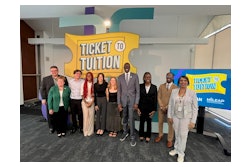SAN FRANCISCO — Despite growing public awareness and collective efforts to increase the ranks of U.S. minority college students seeking degrees in STEM fields, their supporters and advocates still struggle with many of the same issues today as they did several decades ago, a panel of educators says.
That was a consensus during a session this week at the annual meeting of the Association of Public and Land-grant Universities (APLU), which runs through Tuesday.
“Minorities are too often steered into low-achieving programs, and they have academic difficulties from a young age,” says Dr. Sharon Matthews, academy coach at Stratford STEM Magnet High School in Nashville, Tenn., adding that too many social and educational institutions hold “low expectations” for youth of color. The remarks by Matthews and others, to an audience with more than a few heads nodding vigorously, came during a session titled, “Serving New Student Demographics and the APLU Minority Male STEM Initiative.”
Dr. Junius Gonzales, provost and vice president for academic affairs at the University of Texas at El Paso, says college administrators are obliged to weave “compassion into their leadership” because of the high proportion of first-generation college-goers among minorities in STEM disciplines, meaning they often lack academic role models at home. Gonzales mentioned his campus, a Hispanic serving Institution, is juggling challenges stemming from an unexpected 11 percent enrollment spike in its College of Science this school year. “We don’t want to cap this growth whatsoever,” he says, “but we’re also dealing with permanent budget cuts, too.”
On behalf of APLU’s Office for Access and the Advancement of Public Black Universities, Dr. Lorenzo Esters presented preliminary findings of a survey this year of STEM students, faculty and administrators. Focused on best practices in recruitment, retention and graduation of underrepresented students, survey respondents spanned 14 institutions around the country such as Purdue University, New Mexico State University, the University of Hawaii and Florida A&M University.
More than half of minority male student respondents, Esters said, were first-generation college-goers, relied on Pell grants or loans and had annual family incomes that averaged $30,000 or less. “And, I was startled to see that 11 percent of these students worked at least 26 hours a week in outside jobs,” says Esters, who is vice president of OAAPBU.
Just as striking, Esters says, were these seemingly opposing themes: About 82 percent of students described their interactions with STEM faculty as positive, yet 71 percent also said they felt the need to “prove themselves” and 73 percent did not even use the available mentoring programs. Such statistics suggest a need for educators to reduce feelings of isolation among young men of color, Esters says, and to continue to try making them feel welcome in and out of the classroom.
Dr. Sylvia Hurtado, professor and director of the Higher Education Research Institute at the University of California, Los Angeles, says other national surveys have indicated that minority college students in STEM fields typically don’t seek out mentors, meaning faculty need to be as pro-active as possible. A similar impetus holds true in getting young men of color involved in undergraduate research, Hurtado says. “For example, African-American males are four times as likely to participate if there are structured research programs” than if such programs don’t exist.
Meanwhile, the U.S. college population keeps growing more ethnically diverse. In 1980, Whites made up 80 percent of undergraduates but only 62 percent by 2009, according to Dr. Wendell Hall, APLU director of student success and research. From 2000-2009, undergraduate enrollment nationally jumped by more than 7.5 million students; that’s in contrast to the mere 2.5 million increase in students from 1980 to 2000.
Esters says his office will publish the STEM survey findings next month and host a forum at APLU offices in February. Policy briefs pertaining to minority males in STEM disciplines also will be published next year.
Other topics being tackled in APLU convention workshops and plenary sessions this week include the role of urban universities in their communities, workforce issues, international development, the role of land-grant universities in feeding the global population during the next 40 years and the strategies being employed to carry out academic reorganization and consolidation on public university campuses.
|


















